
The Douro is the largest river of the Iberian Peninsula by discharge. It rises near Duruelo de la Sierra in the Spanish province of Soria, meanders briefly south, then flows generally west through the northern part of the Meseta Central in Castile and León into northern Portugal. Its largest tributary is the right-bank Esla. The Douro flows into the Atlantic Ocean at Porto, the second largest city of Portugal.

Castile and León is an autonomous community in northwestern Spain. Castile and León is the largest autonomous community in Spain by area, covering 94,222 km2. It is, however, sparsely populated, with a population density below 30/km2. While a capital has not been explicitly declared, the seats of the executive and legislative powers are set in Valladolid by law, and for all purposes that city serves as the de facto regional capital.
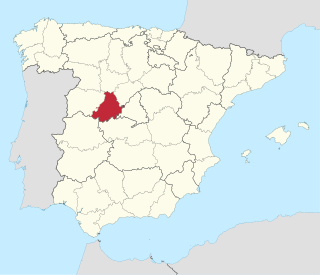
Ávila is a province of central-western Spain, in the southern part of the autonomous community of Castile and León. It is bordered on the south by the provinces of Toledo and Cáceres, on the west by Salamanca, on the north by Valladolid, and on the east by Segovia and Madrid. Ávila has a population of 158,265 (2018) and is ranked 47th out of 50 of Spanish provinces in population. Its capital is Ávila.

Salamanca is a province of western Spain, in the western part of the autonomous community of Castile and León. It is bordered by the provinces of Zamora, Valladolid, Ávila, and Cáceres, and on the west by Portugal. It has an area of 12,349 km2 and in 2018 had a population of 331,473 people. It is divided into 362 municipalities, 11 comarcas, 32 mancomunidades and five judicial districts. Of the 362 municipalities, more than half are villages with fewer than 300 people.
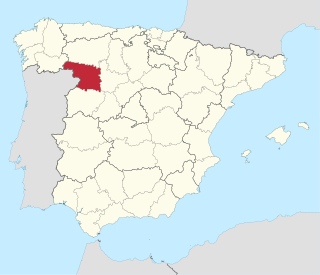
Zamora is a province of western Spain, in the western part of the autonomous community of Castile and León. It is bordered by the provinces of Ourense, León, Valladolid, and Salamanca, and by Portugal.
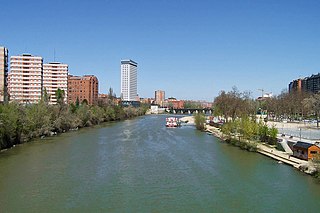
The Pisuerga is a river in northern Spain, the Duero's second largest tributary. It rises in the Cantabrian Mountains in the province of Palencia, autonomous region of Castile and León. Its traditional source is called Fuente Cobre, but it has been discovered that the real source is a glacier higher in the mountains. The river flows south into the Douro river shortly after passing through the city of Valladolid. Its length is approximately 270 kilometres (170 mi).
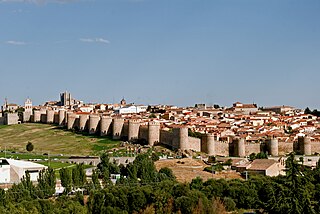
Ávila is a city of Spain located in the autonomous community of Castile and León. It is the capital and most populated municipality of the Province of Ávila.
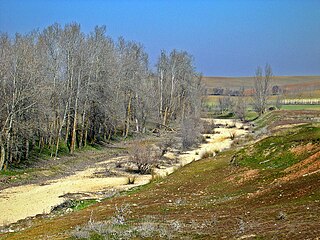
The Trabancos is a river in Spain that flows between the Zapardiel and the Guareña rivers, and is a tributary of the Duero river. The source of the Trabancos is in Moraña, a region in the north of the province of Ávila, near Blascomillán. The Trabancos is at an elevation of approximately 1,100 metres (3,600 ft), is approximately 85 kilometres (53 mi) long and, although its river bed is stable, only has a constant water flow during and immediately after torrential rains.

Aldeadávila de la Ribera is a village and municipality in the north-west of the province of Salamanca, western Spain, part of the autonomous community of Castile and León.

The Autovía A-66 is a major highway in western Spain, part of the European route E803. The road is an upgrade of the N-630 which was undertaken section by section. The route roughly corresponds to the ancient Roman 'Silver Route' connecting the cities of Mérida and Astorga.

La Aldehuela is a municipality of Spain in the province of Ávila, in the autonomous community of Castile and León. It has a 17.04 km² area, a population of 233 inhabitants (2005) and a density of 13.91 people/km².

Fermoselle is a small medieval village located in the province of Zamora, western Spain, and is part of the region of Castile and León in the south-west region of the province. It has a population of fewer than 1500.
Baños de Valdearados is a municipality and town located in the province of Burgos, Castile and León, Spain. According to the 2004 census (INE), the municipality has a population of 424 inhabitants.

El Barco de Ávila is a municipality located in the province of Ávila, Castile and León, Spain. It forms part of the region of El Barco de Ávila - Piedrahíta, and is located in the valley of Tormes River, and is the headboard of the natural region of Alto Tormes. In 2017 it had a population of 2436.

The Almendra Dam, also known as Villarino Dam, in Salamanca, Spain, interrupts the course of the River Tormes five kilometres from the village from which it takes its name: Almendra. It was constructed between 1963 and 1970.
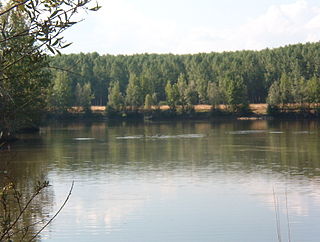
The Esla is a river in the provinces of León and Zamora in the northwest of Spain. It is a tributary of the Duero River that starts in the Cantabrian Mountains and is 275 kilometres (171 mi) long. Its direction of flow is from north to south. It is the largest tributary of the Duero in terms of discharge; in fact, at its mouth at the confluence with the Duero, it has a greater discharge than the volume in the main river.

Salamanca is a municipality and city in Spain, capital of the province of the same name, located in the autonomous community of Castile and León. It is located in the Campo Charro comarca, in the Meseta Norte, in the northwestern quadrant of the Iberian Peninsula. It has a population of 144,436 registered inhabitants. Its stable functional area reaches 203,999 citizens, which makes it the second most populated in the autonomous community, after Valladolid. Salamanca is known for its large number of remarkable Plateresque-style buildings.

The Aldeadávila Dam is a Spanish concrete arch-gravity dam, straddling the border between Spain and Portugal on the Duero River. The nearest town is Aldeadávila de la Ribera in the Province of Salamanca, about 11.3 kilometres (7.0 mi) to the east. The nearest Portuguese town is Fornos in Bragança District, about 8 kilometres (5.0 mi) to the southwest. The Portuguese side of the river around the dam site lies within the Arribes del Duero Natural Park.

The Tiétar is a river located in the Iberian Peninsula, Spain. It originates in the municipality of Rozas de Puerto Real, at the eastern end of the Sierra de Gredos, a mountain range from which it receives numerous tributaries. The river flows through the provinces of Madrid, Ávila, Toledo, and Cáceres, ultimately emptying into the Tagus River at Monfragüe.
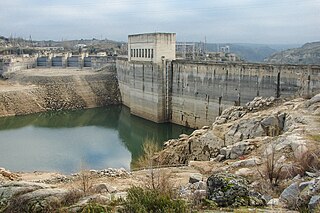
The Ricobayo Dam is a hydroelectric engineering work built on the lower course of the Esla river. It is located less than 1 km from Ricobayo de Alba, in the province of Zamora, Castilla y León, Spain.



















